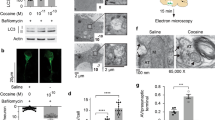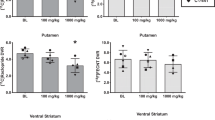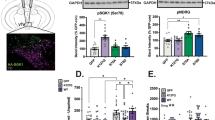Abstract
The increase in dopamine (DA) neurotransmission stimulated by in vivo cocaine exposure is tempered by G protein-dependent inhibitory feedback mechanisms in DA neurons of the ventral tegmental area (VTA). G protein-gated inwardly rectifying K+ (GIRK/Kir3) channels mediate the direct inhibitory effect of GABAB receptor (GABABR) and D2 DA receptor (D2R) activation in VTA DA neurons. Here we examined the effect of the DA neuron-specific loss of GIRK channels on D2R-dependent regulation of VTA DA neuron excitability and on cocaine-induced, reward-related behaviors. Selective ablation of Girk2 in DA neurons did not alter the baseline excitability of VTA DA neurons but significantly reduced the magnitude of D2R-dependent inhibitory somatodendritic currents and blunted the impact of D2R activation on spontaneous activity and neuronal excitability. Mice lacking GIRK channels in DA neurons exhibited increased locomotor activation in response to acute cocaine administration and an altered locomotor sensitization profile, as well as increased responding for and intake of cocaine in an intravenous self-administration test. These mice, however, showed unaltered cocaine-induced conditioned place preference. Collectively, our data suggest that feedback inhibition to VTA DA neurons, mediated by GIRK channel activation, tempers the locomotor stimulatory effect of cocaine while also modulating the reinforcing effect of cocaine in an operant-based self-administration task.
Similar content being viewed by others
Log in or create a free account to read this content
Gain free access to this article, as well as selected content from this journal and more on nature.com
or
References
Ackerman JM, White FJ (1990). A10 somatodendritic dopamine autoreceptor sensitivity following withdrawal from repeated cocaine treatment. Neurosci Lett 117: 181–187.
Arora D, Haluk DM, Kourrich S, Pravetoni M, Fernandez-Alacid L, Nicolau JC et al (2010). Altered neurotransmission in the mesolimbic reward system of Girk mice. J Neurochem 114: 1487–1497.
Arora D, Hearing M, Haluk DM, Mirkovic K, Fajardo-Serrano A, Wessendorf MW et al (2011). Acute cocaine exposure weakens GABA(B) receptor-dependent G-protein-gated inwardly rectifying K+ signaling in dopamine neurons of the ventral tegmental area. J Neurosci 31: 12251–12257.
Backes EN, Hemby SE (2008). Contribution of ventral tegmental GABA receptors to cocaine self-administration in rats. Neurochem Res 33: 459–467.
Beart PM, McDonald D, Gundlach AL (1979). Mesolimbic dopaminergic neurones and somatodendritic mechanisms. Neurosci Lett 15: 165–170.
Beckstead MJ, Grandy DK, Wickman K, Williams JT (2004). Vesicular dopamine release elicits an inhibitory postsynaptic current in midbrain dopamine neurons. Neuron 42: 939–946.
Bello EP, Mateo Y, Gelman DM, Noain D, Shin JH, Low MJ et al (2011). Cocaine supersensitivity and enhanced motivation for reward in mice lacking dopamine D2 autoreceptors. Nat Neurosci 14: 1033–1038.
Blednov YA, Stoffel M, Cooper R, Wallace D, Mane N, Harris RA (2002). Hyperactivity and dopamine D1 receptor activation in mice lacking Girk2 channels. Psychopharmacology (Berl) 159: 370–378.
Brabant C, Quertemont E, Tirelli E (2005). Influence of the dose and the number of drug-context pairings on the magnitude and the long-lasting retention of cocaine-induced conditioned place preference in C57BL/6J mice. Psychopharmacology (Berl) 180: 33–40.
Brebner K, Phelan R, Roberts DC (2000). Intra-VTA baclofen attenuates cocaine self-administration on a progressive ratio schedule of reinforcement. Pharmacol Biochem Behav 66: 857–862.
Chen NH, Reith ME (1994). Autoregulation and monoamine interactions in the ventral tegmental area in the absence and presence of cocaine: a microdialysis study in freely moving rats. J Pharmacol Exp Ther 271: 1597–1610.
Cruz HG, Ivanova T, Lunn M-L, Stoffel M, Slesinger PA, Lüscher C (2004). Bi-directional effects of GABAB receptor agonists on the mesolimbic dopamine system. Nat Neurosci 7: 153–159.
de Jong JW, Roelofs TJ, Mol FM, Hillen AE, Meijboom KE, Luijendijk MC et al (2015). Reducing ventral tegmental dopamine D2 receptor expression selectively boosts incentive motivation. Neuropsychopharmacology 40: 2085–2095.
Di Chiara G, Imperato A (1988). Drugs abused by humans preferentially increase synaptic dopamine concentrations in the mesolimbic system of freely moving rats. Proc Natl Acad Sci USA 85: 5274–5278.
Einhorn LC, Johansen PA, White FJ (1988). Electrophysiological effects of cocaine in the mesoaccumbens dopamine system: studies in the ventral tegmental area. J Neurosci 8: 100–112.
Filip M, Frankowska M, Przegalinski E (2007). Effects of GABA(B) receptor antagonist, agonists and allosteric positive modulator on the cocaine-induced self-administration and drug discrimination. Eur J Pharmacol 574: 148–157.
Groves PM, Wilson CJ, Young SJ, Rebec GV (1975). Self-inhibition by dopaminergic neurons. Science 190: 522–528.
Hearing M, Kotecki L, Marron Fernandez de Velasco E, Fajardo-Serrano A, Chung HJ, Lujan R et al (2013). Repeated cocaine weakens GABA(B)-GIRK signaling in layer 5/6 pyramidal neurons in the prelimbic cortex. Neuron 80: 159–170.
Holroyd KB, Adrover MF, Fuino RL, Bock R, Kaplan AR, Gremel CM et al (2015). Loss of feedback inhibition via D2 autoreceptors enhances acquisition of cocaine taking and reactivity to drug-paired cues. Neuropsychopharmacology 40: 1495–1509.
Kaufmann K, Romaine I, Days E, Pascual C, Malik A, Yang L et al (2013). ML297 (VU0456810), the first potent and selective activator of the GIRK potassium channel, displays antiepileptic properties in mice. ACS Chem Neurosci 4: 1278–1286.
Kotecki L, Hearing M, McCall NM, Marron Fernandez de Velasco E, Pravetoni M, Arora D et al (2015). GIRK channels modulate opioid-induced motor activity in a cell type- and subunit-dependent manner. J Neurosci 35: 7131–7142.
Koyrakh L, Lujan R, Colon J, Karschin C, Kurachi Y, Karschin A et al (2005). Molecular and cellular diversity of neuronal G-protein-gated potassium channels. J Neurosci 25: 11468–11478.
Kushner SA, Unterwald EM (2001). Chronic cocaine administration decreases the functional coupling of GABA(B) receptors in the rat ventral tegmental area as measured by baclofen-stimulated 35S-GTPγS binding. Life Sci 69: 1093–1102.
Labouebe G, Lomazzi M, Cruz HG, Creton C, Lujan R, Li M et al (2007). RGS2 modulates coupling between GABAB receptors and GIRK channels in dopamine neurons of the ventral tegmental area. Nat Neurosci 10: 1559–1568.
Lalive AL, Munoz MB, Bellone C, Slesinger PA, Luscher C, Tan KR (2014). Firing modes of dopamine neurons drive bidirectional GIRK channel plasticity. J Neurosci 34: 5107–5114.
Lammel S, Hetzel A, Hackel O, Jones I, Liss B, Roeper J (2008). Unique properties of mesoprefrontal neurons within a dual mesocorticolimbic dopamine system. Neuron 57: 760–773.
Leite-Morris KA, Fukudome EY, Shoeb MH, Kaplan GB (2004). GABA(B) receptor activation in the ventral tegmental area inhibits the acquisition and expression of opiate-induced motor sensitization. J Pharmacol Exp Ther 308: 667–678.
Liang JH, Chen F, Krstew E, Cowen MS, Carroll FY, Crawford D et al (2006). The GABA(B) receptor allosteric modulator CGP7930, like baclofen, reduces operant self-administration of ethanol in alcohol-preferring rats. Neuropharmacology 50: 632–639.
Lujan R, Marron Fernandez de Velasco E, Aguado C, Wickman K (2014). New insights into the therapeutic potential of GIRK channels. Trends Neurosci 37: 20–29.
Lunn ML, Nassirpour R, Arrabit C, Tan J, McLeod I, Arias CM et al (2007). A unique sorting nexin regulates trafficking of potassium channels via a PDZ domain interaction. Nat Neurosci 10: 1249–1259.
Mirkovic K, Palmersheim J, Lesage F, Wickman K (2012). Behavioral characterization of mice lacking Trek channels. Front Behav Neurosci 6: 60.
Morgan AD, Carroll ME, Loth AK, Stoffel M, Wickman K (2003). Decreased cocaine self-administration in Kir3 potassium channel subunit knockout mice. Neuropsychopharmacology 28: 932–938.
Nestler EJ (2005). Is there a common molecular pathway for addiction? Nat Neurosci 8: 1445–1449.
Pierce RC, Kalivas PW (1997). A circuitry model of the expression of behavioral sensitization to amphetamine-like psychostimulants. Brain Res Brain Res Rev 25: 192–216.
Pravetoni M, Wickman K (2008). Behavioral characterization of mice lacking GIRK/Kir3 channel subunits. Genes Brain Behav 7: 523–531.
Ranaldi R, Poeggel K (2002). Baclofen decreases methamphetamine self-administration in rats. Neuroreport 13: 1107–1110.
Robinson TE, Berridge KC (2001). Incentive-sensitization and addiction. Addiction 96: 103–114.
Sesack SR, Aoki C, Pickel VM (1994). Ultrastructural localization of D2 receptor-like immunoreactivity in midbrain dopamine neurons and their striatal targets. J Neurosci 14: 88–106.
Sharpe AL, Varela E, Bettinger L, Beckstead MJ (2014). Methamphetamine self-administration in mice decreases GIRK channel-mediated currents in midbrain dopamine neurons. Int J Neuropsychopharmacol 18: pii: pyu073.
Steketee JD, Kalivas PW (1991). Sensitization to psychostimulants and stress after injection of pertussis toxin into the A10 dopamine region. J Pharmacol Exp Ther 259: 916–924.
Waddington JL, Cross AJ (1978). Neurochemical changes following kainic acid lesions of the nucleus accumbens: implications for a GABAergic accumbal-ventral tegmental pathway. Life Sci 22: 1011–1014.
Wolf P, Olpe HR, Avrith D, Haas HL (1978). GABAergic inhibition of neurons in the ventral tegmental area. Experientia 34: 73–74.
Wydeven N, de Velasco EMF, Du Y, Benneyworth MA, Hearing MC, Fischer RA et al (2014). Mechanisms underlying the activation of G-protein-gated inwardly rectifying K+ (GIRK) channels by the novel anxiolytic drug, ML297. Proc Natl Acad Sci USA 111: 10755–10760.
Xi ZX, Stein EA (2000). Increased mesolimbic GABA concentration blocks heroin self-administration in the rat. J Pharmacol Exp Ther 294: 613–619.
Zweifel LS, Argilli E, Bonci A, Palmiter RD (2008). Role of NMDA receptors in dopamine neurons for plasticity and addictive behaviors. Neuron 59: 486–496.
Acknowledgements
We thank Zhilian Xia for exceptional care of the mouse colony at the University of Minnesota and Dr Ramaswamy Sharma for genotyping mice bred in San Antonio.
Author information
Authors and Affiliations
Corresponding author
Additional information
Supplementary Information accompanies the paper on the Neuropsychopharmacology website
Supplementary information
Rights and permissions
About this article
Cite this article
McCall, N., Kotecki, L., Dominguez-Lopez, S. et al. Selective Ablation of GIRK Channels in Dopamine Neurons Alters Behavioral Effects of Cocaine in Mice. Neuropsychopharmacol 42, 707–715 (2017). https://doi.org/10.1038/npp.2016.138
Received:
Revised:
Accepted:
Published:
Issue date:
DOI: https://doi.org/10.1038/npp.2016.138
This article is cited by
-
Interaction between maternal immune activation and peripubertal stress in rats: impact on cocaine addiction-like behaviour, morphofunctional brain parameters and striatal transcriptome
Translational Psychiatry (2023)
-
Ibrutinib as a potential therapeutic for cocaine use disorder
Translational Psychiatry (2021)
-
A Single Prior Injection of Methamphetamine Enhances Methamphetamine Self-Administration (SA) and Blocks SA-Induced Changes in DNA Methylation and mRNA Expression of Potassium Channels in the Rat Nucleus Accumbens
Molecular Neurobiology (2020)
-
Ethanol-induced conditioned place preference and aversion differentially alter plasticity in the bed nucleus of stria terminalis
Neuropsychopharmacology (2019)



